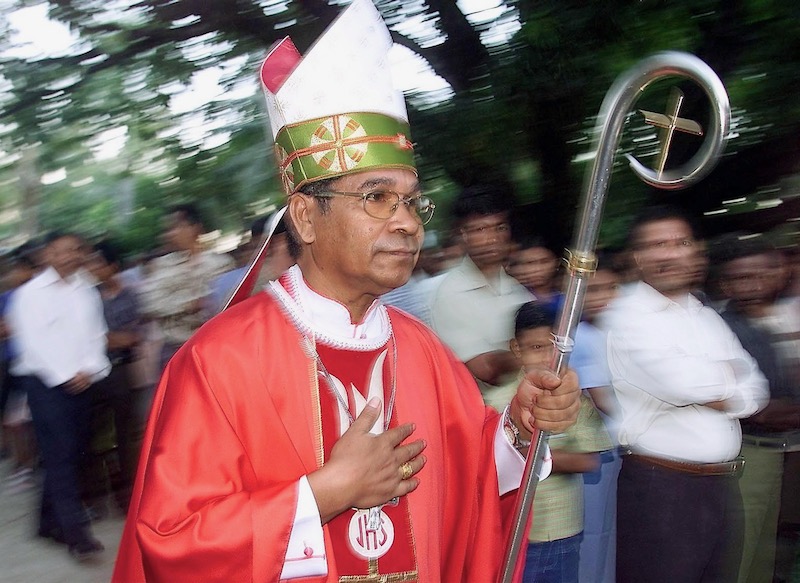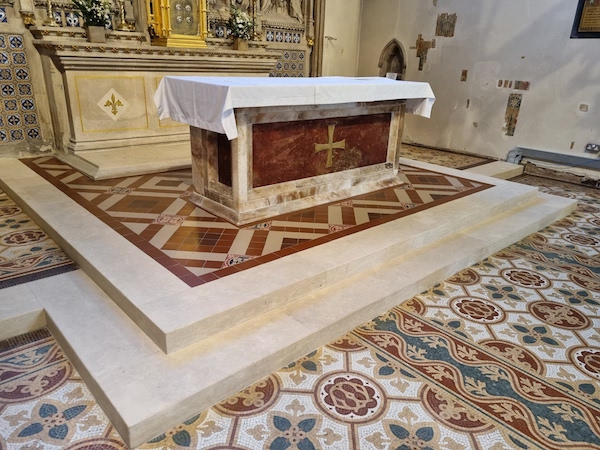A fine late Victorian forward altar has been installed in Shrewsbury Cathedral, marking an important stage in an extensive programme of restoration.
The new altar was given free of charge by the authorities at Ely Cathedral. It was previously in a side chapel dedicated to St Catherine which has been repurposed.
Dating from 1896, the altar is red marble and alabaster and a good fit for Gothic Revival splendour of Edward Pugin’s cathedral at Shrewsbury. The same deep red appears in Pugin’s encaustic Minton floor tiles which were discovered as the sanctuary was being restored. The tiles had been covered by a carpet as part of a reordering in 1984. At that time the sanctuary was extended deep into the nave and many original furnishings removed and broken up.
The Bishop of Shrewsbury, Mark Davies, has been undoing the 1980s reordering and attempting, as far as possible, to revive the architect’s original vision for the cathedral. He believes the Ely altar harmonises with the historic beauty of the sanctuary.
He told The Tablet: “The whole work of renewal is built around the altar and so we are grateful to the Dean and Chapter of Ely for enabling this altar of special beauty to take its place in Shrewsbury Cathedral. A new mensa is in preparation and will be consecrated with the relics of the saints.”
The altar was designed by Philip Coldwell Thicknesse (1860-1920) of Liverpool who trained with Norman Shaw and entered partnership with William Willink in 1884. Its position at the far end of the sanctuary was determined after a period of experimentation with a temporary forward altar. Masses in both the Ordinary and Extraordinary form are celebrated at the cathedral.
Bishop Davies’s restoration began in 2015 and the next phase will be to replace the heating and lighting systems. It is eventually hoped to reproduce paintings on the sanctuary arch by Joseph Aloysius Pippet that were painted over.
Dedicated to Our Lady Help of Christians and St Peter of Alcantara, the cathedral was consecrated in 1856 by Cardinal Nicholas Wiseman. It was one of the first purpose-built cathedrals in England following the restoration of the Catholic hierarchy, and also one of the smallest.
Meanwhile, Nottingham Cathedral has received a significant lottery grant for its “Restore Pugin” project in collaboration with Nottingham Trent University. A development grant of £277,558, with a further possible £524,858 for the implementation of the project, will support the restoration of three chapels at the east end of the Grade II* listed building, to return the interior to Augustus Welby Pugin’s original 1840s design.
Investigations of the chapels’ paintwork have found that the original decoration could be revealed behind layers of later paintwork.
Sophia Andreae, vice chair of the bishops’ conference patrimony committee, said: “The original Pugin decorative scheme in Nottingham Cathedral would once have filled the building with colour, contributing greatly to the sense of the sacred. Following a number of grants in recent years which have seen the exterior of the cathedral made wind and watertight, now is the time to focus on the interior and to restore it to its original glory.”
The Church of St Barnabus opened in 1844, and was raised to cathedral status in 1852 after the re-establishment of the Catholic hierarchy in 1850 – one of the first four Catholic cathedrals in England since the Reformation, along with Birmingham, Southwark, and Salford.
Most of the interior is in the Early English Plain Gothic style, with the chapels at the east end in the Decorated style most associated with Pugin. His original designs for the interior were never completed, and although the Blessed Sacrament chapel was restored in 1933 most other decoration was erased during re-ordering in 1962.



 Loading ...
Loading ...